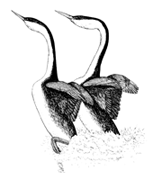Papers in the Biological Sciences

Diving Birds of North America by Paul A. Johnsgard
Date of this Version
April 1987
Document Type
Book Chapter
Abstract
Loons are large diving birds having long, straight, and acutely pointed bills, with feathers covering the lores (region between eye and bill) and extending to the linear nostrils. There are 10 functional primaries and 22–23 secondaries, the inner secondaries shorter than the primaries. Molting of the remiges (flight feathers) is simultaneous, and the wings are not used for underwater propulsion. The 16–20 rectrices (tail feathers) are short and stiff. The body feathers are shiny and water-resistant; aftershafts and adult down feathers are present. The legs are set extremely far back on the body, making standing very difficult and walking or takeoff from land nearly impossible. The tarsus is laterally compressed, with reticulated (network-like) scales, and is unserrated behind. The lobed hallux (hind toe) is long and slightly elevated, the front toes are fully webbed, and all the toes have sharp claws. The wings are long and pointed, and the body is somewhat elongated, with a fairly long neck. The adults have white underparts, and in most species both sexes are spotted or striped with black and white on the back and neck during the breeding season. All species are monogamous, with distinct breeding and wintering plumages that lack sexual dimorphism. The nests are built of vegetational debris and placed at the water's edge. The eggs (usually 2) are spotted and are elliptical to ovate, and the young are unpatterned and nidifugous, with two successive coats of uniformly brownish down. The family has a Holarctic distribution, and all the species are migratory, wintering primarily on salt water and breeding solitarily on freshwater lakes or large tundra ponds. Their foods are primarily fish and aquatic invertebrates, but they also eat small amounts of plant materials. Four extant species are usually recognized, all having breeding ranges that include North America, primarily in boreal and arctic regions.
Red-throated Loon (Red-throated Diver)
Arctic Loon (Black-throated Diver)
Common Loon (Great Northern Diver)
Yellow-billed Loon (White-billed Diver)


Comments
From Diving Birds of North America (1987) by Paul A. Johnsgard. Copyright © 2007 Paul Johnsgard. Cite this work as: Paul Johnsgard, Diving Birds of North America (Lincoln, Nebraska: University of Nebraska Press, 1987; University of Nebraska–Lincoln Libraries, 2008 [ebook edition]).